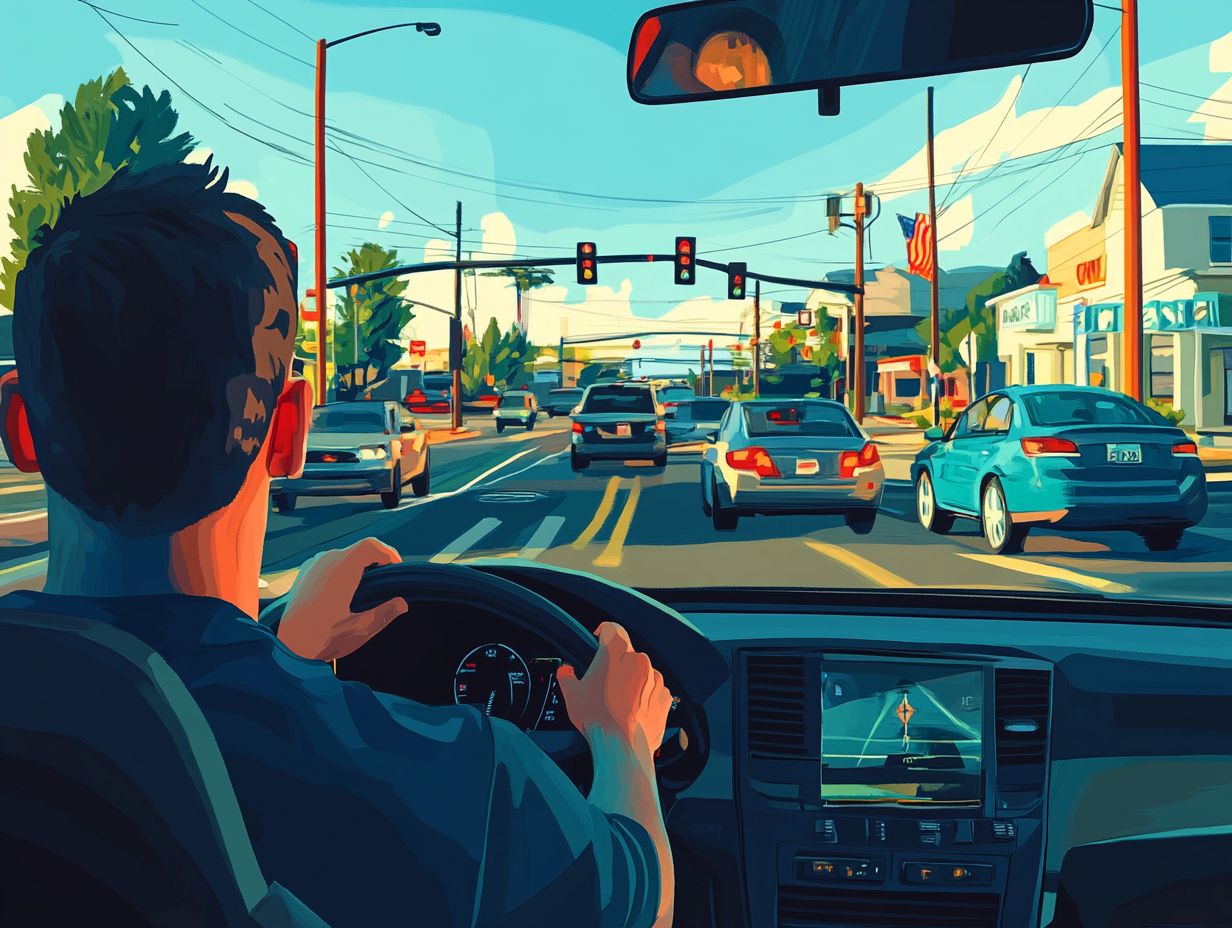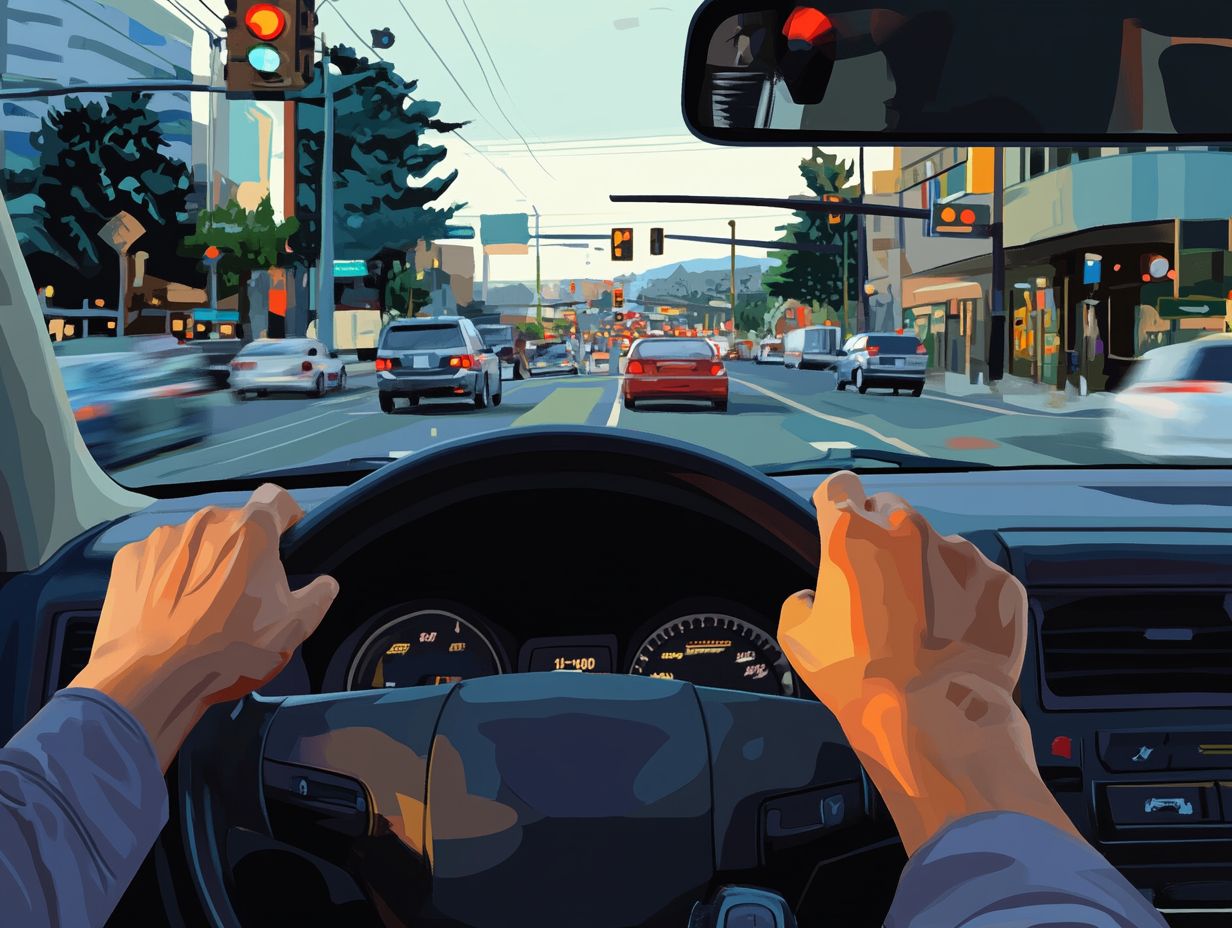5 Best Practices for High-Risk Drivers on the Road
Driving can feel overwhelming, particularly for high-risk drivers. Whether it s due to inexperience, previous incidents, or certain habits, understanding basic road safety is essential.
Let s explore five key practices that can transform your driving and keep you safe. You ll discover the importance of adhering to traffic laws, remaining vigilant, ensuring your vehicle is well-maintained, and exploring the benefits of defensive driving courses.
Let s dive in and discover how you can boost your driving skills!
Contents
- Key Takeaways:
- 1. Always Follow Traffic Laws and Regulations
- 2. Stay Alert and Focused While Driving
- 3. Keep a Safe Distance from Other Vehicles
- 4. Regularly Maintain Your Vehicle
- 5. Consider Taking Defensive Driving Courses
- What Makes a Driver High-Risk?
- Frequently Asked Questions
- What are the 5 best practices for high-risk drivers on the road?
- Why is maintaining focus important for high-risk drivers?
- What traffic laws should high-risk drivers pay special attention to?
- How does regular vehicle maintenance help high-risk drivers?
- What are common distractions that high-risk drivers should avoid?
- Why is defensive driving essential for high-risk drivers?
Key Takeaways:

1. Always Follow Traffic Laws and Regulations
Following traffic laws and regulations is crucial for ensuring the safety of everyone on the road. Your commitment to these laws can substantially minimize the risks linked to distracted driving and car accidents.
Consider this: the National Highway Traffic Safety Administration (NHTSA) reported over 36,000 fatalities on U.S. roads in a single year. This heartbreaking statistic serves as a stark reminder of the potential consequences stemming from negligent behaviors, such as driving under the influence (DUI) or while impaired (DWI).
These violations don’t just put everyone including passengers, pedestrians, and other drivers at risk. By adhering to established regulations, you play a vital role in fostering a culture of safe driving practices, which can help reduce the alarming statistics associated with traffic incidents.
Your compliance with these laws creates a safer driving environment and promotes accountability, significantly lowering the chances of accidents and their repercussions.
2. Stay Alert and Focused While Driving
Staying alert and focused while driving is essential for avoiding distractions that could lead to serious accidents and traffic injuries, particularly for teen drivers who may still be honing their skills.
In our fast-paced world, the risks associated with mobile phone use and cognitive decline from fatigue can severely compromise your attention on the road. Statistics show that texting while driving increases the likelihood of an accident by an astonishing 23 times a staggering figure that emphasizes the necessity of vigilance.
Here are some effective strategies to help you stay focused while driving:
- Setting your phone to ‘Do Not Disturb’ mode
- Taking regular breaks during long journeys
- Practicing mindfulness to sharpen your concentration
By prioritizing focus, you not only minimize distractions but also contribute to a safer driving environment for yourself and everyone else on the road.
3. Keep a Safe Distance from Other Vehicles
Maintaining a safe distance from other vehicles is vital for preventing crashes. It gives you the necessary time to react to sudden changes in traffic conditions, significantly reducing the risk of accidents.
This distance becomes even more crucial when you’re navigating busy highways or facing adverse weather conditions like rain, snow, or fog, where visibility and traction can take a serious hit. A good rule of thumb is to keep at least a three-second gap between your vehicle and the one in front of you when driving at normal speeds. In challenging conditions, consider extending that distance to five or even six seconds.
Remember, reducing your speed during inclement weather is also a smart move. A longer following distance allows you more time to slow down and respond effectively to any emergencies that may arise.
Remember, every safe choice on the road can make a difference. Drive safe and protect yourself and others!
4. Regularly Maintain Your Vehicle

Regular vehicle maintenance is essential for ensuring that your driving controls operate flawlessly. It also optimizes safety in various driving conditions, helping to prevent accidents and enhance your overall driving experience.
You might overlook basic checks, but routinely inspecting your brakes, tires, and lights can dramatically reduce the chances of unexpected breakdowns. Your brakes should respond smoothly and effectively, ensuring you can stop quickly in emergency situations.
Properly inflated and well-treaded tires are crucial for providing the traction and stability you need on the road. Making sure all your lights are operational boosts your visibility and clearly communicates your intentions to other road users. This fosters a safer environment for everyone.
By prioritizing these maintenance practices, you can significantly minimize the risks associated with car problems and enjoy a more confident and secure journey.
5. Consider Taking Defensive Driving Courses
Taking defensive driving courses can elevate your driving skills and instill a profound sense of responsibility behind the wheel. These programs equip you with essential techniques to anticipate and respond to potential hazards on the road.
In these courses, you ll explore critical topics such as understanding traffic laws and recognizing how weather conditions impact driving. You ll also learn about practicing safe following distances. By enhancing your awareness, you ll spot risky behaviors both in yourself and in others.
Completing a defensive driving course can yield tangible benefits like reduced insurance premiums and a lower risk of traffic violations. Ultimately, these courses cultivate safer driving habits that enrich your experience and contribute to a more secure community on the roads.
What Makes a Driver High-Risk?
A high-risk driver is someone whose driving behavior significantly raises the chances of being involved in a car accident. Factors like alcohol impairment, lack of supervision, and inexperience especially among teen drivers play a significant role.
Individuals who engage in reckless habits, such as speeding and aggressive maneuvering, turn everyday driving into a perilous situation. When alcohol is involved, reaction times plummet and judgment falters, leading to potentially fatal miscalculations behind the wheel.
Addressing these issues highlights the vital importance of proper supervision. Novice drivers benefit greatly from guidance as they refine their skills. Incorporating responsible driving education sheds light on these risks and cultivates a culture of accountability, promoting safer road experiences for everyone.
What Are the Common Causes of High-Risk Driving?
High-risk driving often stems from common culprits: alcohol impairment, distracted driving, and speeding. Each significantly elevates the risk of road traffic injuries and fatalities, and understanding the common mistakes high-risk drivers make with insurance can help mitigate these risks.
Statistics reveal that nearly 29 people in the United States lose their lives each day due to alcohol-related crashes. This shocking fact highlights the immediate need to act against impaired driving. Distracted driving, which includes texting or using a mobile phone, causes approximately 391,000 injuries annually. When you factor in speeding known for amplifying both the likelihood and severity of collisions you create a truly dangerous atmosphere on the roads.
To tackle these high-risk behaviors, drivers must prioritize safety by:
- Opting for designated drivers
- Setting their phones to Do Not Disturb while on the road
- Adhering strictly to speed limits
Embracing these preventive measures can significantly lessen the chances of accidents and elevate overall driving safety, including tips for safe driving to lower premium rates.
What Are the Consequences of High-Risk Driving?

High-risk driving can lead to severe consequences. These include traffic tickets, legal penalties like DUI and DWI charges, and tragic accident reports.
These violations lead to hefty fines and can result in license suspension and skyrocketing insurance premiums. Such outcomes can significantly impact your financial stability.
Many drivers underestimate the seriousness of their actions. Statistics show that nearly 28 people die every day in the United States due to drunk-driving accidents. This underscores the urgent need for awareness.
Imagine facing the life-altering consequences of a DUI conviction. A driver convicted for DUI might deal with criminal charges and ongoing financial repercussions, including legal fees and lost job opportunities.
This situation highlights the far-reaching impacts of reckless driving behavior. One moment of poor judgment can change everything.
How Can a High-Risk Driver Improve Their Driving Skills?
High-risk drivers have the opportunity to enhance their driving skills through tailored education programs focusing on safe driving methods and effective risk management strategies.
Take the first step by enrolling in a defensive driving course today! You’ll learn to anticipate potential hazards, respond effectively, and make safer decisions behind the wheel.
Regularly practicing safe driving habits, such as maintaining a safe following distance and adhering to speed limits, can greatly reduce the likelihood of accidents and can help you discover 5 ways to improve your insurance status as a high-risk driver.
Utilizing driving assessments helps pinpoint your strengths and weaknesses. This gives you the tools to focus on specific areas for improvement.
The cumulative benefits of these enhanced skills boost your personal safety and foster a safer driving environment for everyone on the road.
What Are the Benefits of Being a Safe Driver?
Being a safe driver offers a wealth of benefits. These include a reduced likelihood of car accidents, lower insurance premiums, and a profound sense of responsibility that enhances overall road safety.
Your commitment to safe driving habits can transform society. Research shows that communities with higher safe driving rates experience a significant drop in road traffic injuries.
This leads to fewer hospitalizations and decreased healthcare costs. By encouraging responsible driving behaviors, you help cultivate a culture of safety that inspires others.
In fact, areas with educational programs on safe driving have seen up to a 20% reduction in fatal accidents.
Ultimately, promoting safe driving not only elevates your well-being but also fosters a shared commitment to creating safer roads for everyone.
What Steps Can Drivers Take to Reduce Their Risk on the Road?
You can take several proactive steps to reduce your risk on the road. Start by adhering to driving tips and maintaining safe driving habits. Additionally, consider following these tips for managing your high-risk driver insurance while keeping an emergency kit in your vehicle.
Implementing these strategies prepares you for unexpected situations and helps you navigate various driving conditions with greater confidence.
Awareness of weather changes and roadway hazards is essential. Heavy rain or fog, for example, can significantly impair your visibility and road traction.
Assemble an emergency kit filled with essential items, like a flashlight, first aid supplies, jumper cables, and non-perishable snacks. These resources can provide crucial support during crises.
Having these items readily available allows you to respond effectively, minimizing potential risks and enhancing your overall safety on the roads.
Frequently Asked Questions

What are the 5 best practices for high-risk drivers on the road?
The 5 best practices for high-risk drivers on the road are: maintaining focus, following traffic laws, regular vehicle maintenance, avoiding distractions, and driving defensively.
Why is maintaining focus important for high-risk drivers?
Maintaining focus is crucial for high-risk drivers. It keeps them alert and aware of potential hazards, which reduces the chances of accidents.
What traffic laws should high-risk drivers pay special attention to?
High-risk drivers must pay attention to speed limits and stop signs. Following these rules is crucial, and considering 5 insurance tips for new high-risk drivers can further ensure safe driving for everyone on the road.
How does regular vehicle maintenance help high-risk drivers?
Regular vehicle maintenance is vital! It keeps your vehicle in top shape and minimizes the risk of breakdowns while driving.
What are common distractions that high-risk drivers should avoid?
High-risk drivers should avoid distractions like texting, eating, or adjusting music while driving, as these can take their focus away from the road. Additionally, implementing strategies for high-risk drivers to save money can also help reduce overall expenses.
Why is defensive driving essential for high-risk drivers?
Defensive driving is crucial. It helps drivers anticipate and avoid potential hazards, keeping everyone safe on the road.






